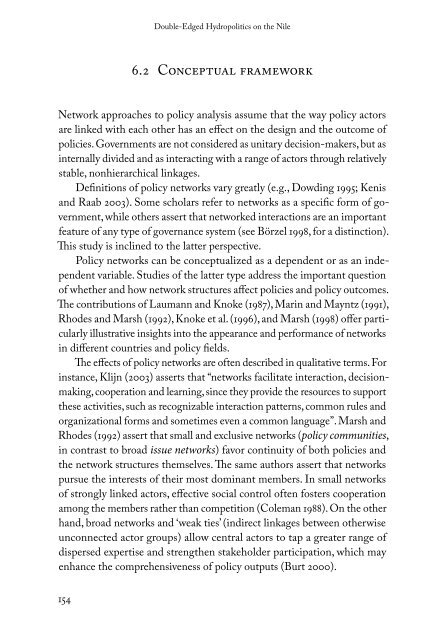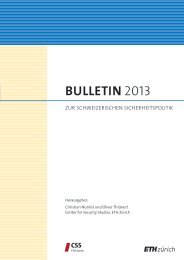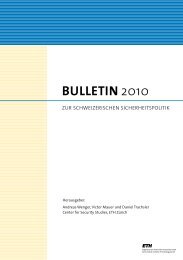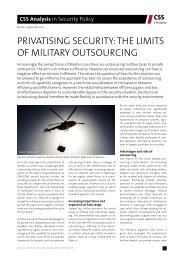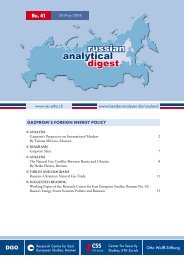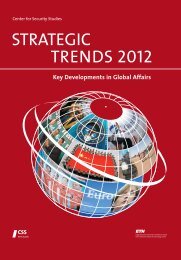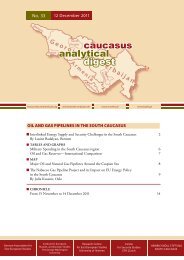Double-Edged Hydropolitics on the Nile - Center for Security Studies ...
Double-Edged Hydropolitics on the Nile - Center for Security Studies ...
Double-Edged Hydropolitics on the Nile - Center for Security Studies ...
Create successful ePaper yourself
Turn your PDF publications into a flip-book with our unique Google optimized e-Paper software.
<str<strong>on</strong>g>Double</str<strong>on</strong>g>-<str<strong>on</strong>g>Edged</str<strong>on</strong>g> <str<strong>on</strong>g>Hydropolitics</str<strong>on</strong>g> <strong>on</strong> <strong>the</strong> <strong>Nile</strong><br />
6.2 C<strong>on</strong>ceptual framework<br />
Network approaches to policy analysis assume that <strong>the</strong> way policy actors<br />
are linked with each o<strong>the</strong>r has an effect <strong>on</strong> <strong>the</strong> design and <strong>the</strong> outcome of<br />
policies. Governments are not c<strong>on</strong>sidered as unitary decisi<strong>on</strong>-makers, but as<br />
internally divided and as interacting with a range of actors through relatively<br />
stable, n<strong>on</strong>hierarchical linkages.<br />
Definiti<strong>on</strong>s of policy networks vary greatly (e.g., Dowding 1995; Kenis<br />
and Raab 2003). Some scholars refer to networks as a specific <strong>for</strong>m of government,<br />
while o<strong>the</strong>rs assert that networked interacti<strong>on</strong>s are an important<br />
feature of any type of governance system (see Börzel 1998, <strong>for</strong> a distincti<strong>on</strong>).<br />
This study is inclined to <strong>the</strong> latter perspective.<br />
Policy networks can be c<strong>on</strong>ceptualized as a dependent or as an independent<br />
variable. <strong>Studies</strong> of <strong>the</strong> latter type address <strong>the</strong> important questi<strong>on</strong><br />
of whe<strong>the</strong>r and how network structures affect policies and policy outcomes.<br />
The c<strong>on</strong>tributi<strong>on</strong>s of Laumann and Knoke (1987), Marin and Mayntz (1991),<br />
Rhodes and Marsh (1992), Knoke et al. (1996), and Marsh (1998) offer particularly<br />
illustrative insights into <strong>the</strong> appearance and per<strong>for</strong>mance of networks<br />
in different countries and policy fields.<br />
The effects of policy networks are often described in qualitative terms. For<br />
instance, Klijn (2003) asserts that “networks facilitate interacti<strong>on</strong>, decisi<strong>on</strong>making,<br />
cooperati<strong>on</strong> and learning, since <strong>the</strong>y provide <strong>the</strong> resources to support<br />
<strong>the</strong>se activities, such as recognizable interacti<strong>on</strong> patterns, comm<strong>on</strong> rules and<br />
organizati<strong>on</strong>al <strong>for</strong>ms and sometimes even a comm<strong>on</strong> language”. Marsh and<br />
Rhodes (1992) assert that small and exclusive networks (policy communities,<br />
in c<strong>on</strong>trast to broad issue networks) favor c<strong>on</strong>tinuity of both policies and<br />
<strong>the</strong> network structures <strong>the</strong>mselves. The same authors assert that networks<br />
pursue <strong>the</strong> interests of <strong>the</strong>ir most dominant members. In small networks<br />
of str<strong>on</strong>gly linked actors, effective social c<strong>on</strong>trol often fosters cooperati<strong>on</strong><br />
am<strong>on</strong>g <strong>the</strong> members ra<strong>the</strong>r than competiti<strong>on</strong> (Coleman 1988). On <strong>the</strong> o<strong>the</strong>r<br />
hand, broad networks and ‘weak ties’ (indirect linkages between o<strong>the</strong>rwise<br />
unc<strong>on</strong>nected actor groups) allow central actors to tap a greater range of<br />
dispersed expertise and streng<strong>the</strong>n stakeholder participati<strong>on</strong>, which may<br />
enhance <strong>the</strong> comprehensiveness of policy outputs (Burt 2000).<br />
154


